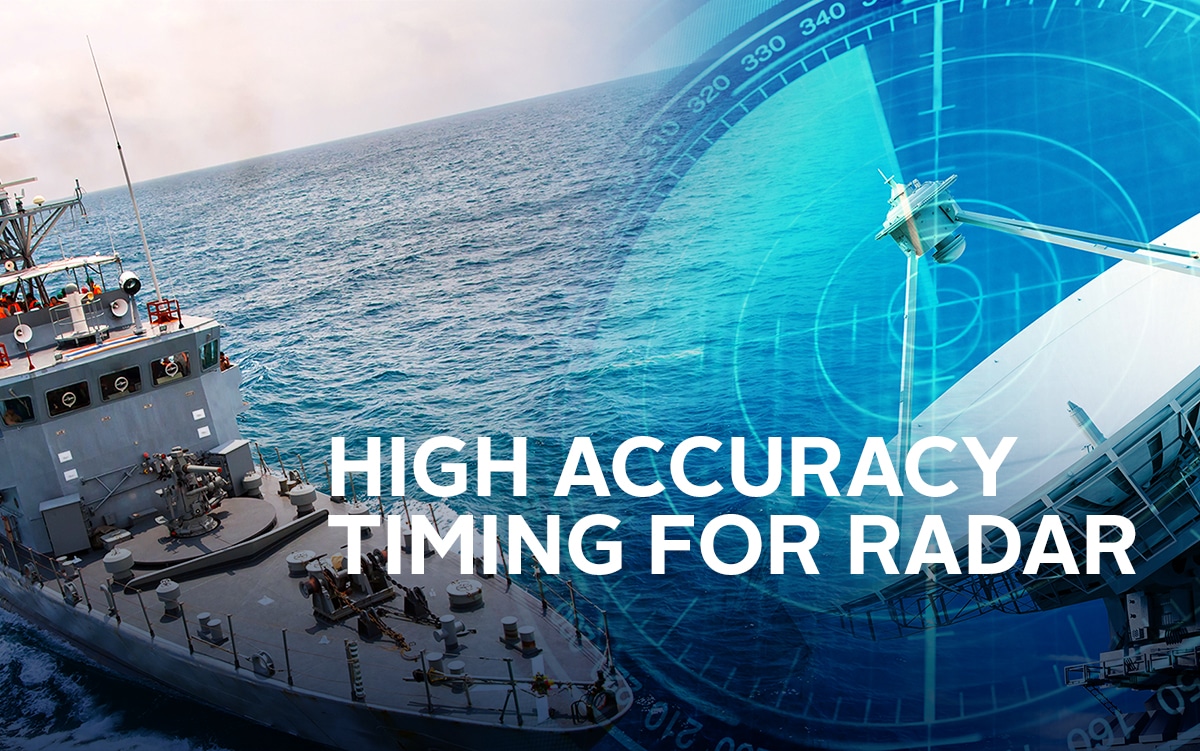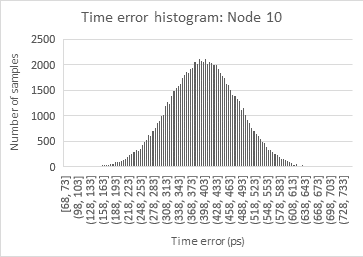
# Case Studies
High Accuracy Timing for Radar
WHITE RABBIT and IEEE-1588-2019 – Defense Applications
C5ISR (Command, Control, Communications, Computers, Cyber, Intelligence, Surveillance and Reconnaissance) systems allow the integration of stored and real-time information to ensure accurate situational awareness on the battlefield.
That system of systems (SoS) would consist, among other things, of a set of sensors (Radars), weapons and command and control centers which exchange synchronized timely data over reliable low latency networks.
User Challenges
- Provide a very stable frequency signal with low phase noise to the radar’s local oscillators and up/down converters..
- Provide a very accurate timing signal with low jitter for event triggering and time stamping.
- Generate the proper synchronizing signals to the radiating elements of the phase array antennas.
- Maximize the availability of the system and synchronization signals.
- Provide countermeasures against interference, jamming and spoofing.
- Ensure system scalability.
- Provide failover mechanisms, cybersecurity, and timing error detection features.
- Allow the utilization of networking configuration and monitoring tools.
- Provide interoperability with COTS devices based on Ethernet interfaces.
- Provide sub-ns synchronization performance in wide area networks.
Context
C5ISR (Command, Control, Communications, Computers, Cyber, Intelligence, Surveillance and Reconnaissance) systems allow the integration of stored and real-time information to ensure accurate situational awareness on the battlefield and achieve technical superiority.
That system of systems (SoS) would consist, among other things, of a set of sensors (Radars), weapons, and command and control centers which exchange synchronized data over reliable low latency networks (Figure 1).

The objective of this communication among radars, weapons, and command and control centers is to find the enemy, fix it, track it, engage it, and assess it. To achieve this in an efficient way and with the best possible performance in distributed systems, the correct time and frequency synchronization of the equipment becomes crucial.
In order to understand the key points of this synchronization, it is necessary to understand the main element of the system, the radar.
Radar in military is primarily used for air traffic control (ATC), surveillance of air and ground, early warning detection of missiles, and navigation at sea. Typically, radars are segmented into ground based, airborne, space based, and naval.
Thanks to the evolution of technology (much more efficient transmitters, phased array antennas, improved phase/frequency performance, etc.), it is possible to deploy networks and fuse air situational awareness information from many sources (1000s of tracks at once) by highspeed data exchanged among many nodes.
Considering a simplified scheme where a transmitter, an antenna, and a receiver are used (Figure 2), a signal of high energy level will be transmitted, received, and processed
after hitting a target.
From this, it will be possible to obtain the position and speed of the target in real time by measuring three things:
- Time delay from instant of transmission to instant of reception to determine range: 3 ns ~ 1 m.
- Frequency (or doppler) shift in reflected signal to determine radial velocity.
- Pointing angle of the tracking antenna (azimuth and elevation) which moves to maximize the signal received from the target.


A more detailed view of this simplified scheme (Figure 3) expands the transmitter and receiver. After the generation of the signal in the transmitter (right side of the image), it is necessary to up convert the RF signal and amplify it in power. Similarly, in the receiver (left side of the image) it is necessary to carefully amplify (low noise) the weak signal received and down convert it to baseband. Both conversion processes are steered by a local oscillator whose frequency must be very stable in the short term due to the speed of the target and with very low phase noise since it will mix with the transmitted and received signal in the up and down conversion. The more stable the signal is, the better the reflected signal from the target can be extracted from the noise (improving detection range for smaller and slower targets).
As part of the signal processing, successive acquisitions are time stamped for signal correlation and, depending on the type of radar, used for interferometry. The reliability of that timing synchronization over long time periods and very low jitter in short time periods is essential for performing those functions locally and correlating that across systems.
For simplicity of the explanation, a monostatic radar has been used as an example. However, the real challenge appears when the system is distributed (bistatic and multistatic radars). That distribution is the key of for C5ISR systems.
In the next section, we will describe how the IEEE-1588- 2019 High Accuracy (HA) protocol can be useful for this type of distributed applications with very demanding time and frequency requirements. We will also give some details about how it is being used in the synchronization of Phased Array Antennas, all using Ethernet interfaces.
The Solution
Recently, the new IEEE-1588-2019 HA protocol standard has been released. This new version includes an extension for wide area network (WAN) utilization, cybersecurity mechanisms, the High Accuracy (HA) profile to distribute time with a time transfer accuracy better than 1 ns, and frequency with very low jitter and phase noise. As indicated in the standard, this profile is strongly based on the White Rabbit (WR) protocol. Its scalability and accuracy across distances of thousands of kilometers and multiple hops, how its accuracy is kept across multiple hops, as well as the capability to integrate the technology using existing optical telecommunication networks has been demonstrated. Moreover, Orolia’s IEEE-1588-2019 HA implementation provides network-based failover, traceability monitoring, and interoperability with multiple time protocols.
The mentioned characteristics of the White Rabbit (WR) technology, makes it a very suitable alternative to meet most demanding requirements in terms of time and frequency distribution related to radar applications and, at the same time, having all the benefits of using ethernet data networks.
White Rabbit (WR) allows distribution of frequency across the network to deliver the same clock reference to all the transmitter and receiver elements of multiple radars over the network, ensuring very low jitter and phase noise frequency signals so that it is not necessary to just rely on local oscillators.
At the same time, White Rabbit (WR) allows to transfer time with very high accuracy to separate distributed locations where the acquisition and signal processing take place, ensuring an accurate phase information in all the elements within the same radar system.
Figure 4 shows a general reference topology of how a White Rabbit (WR) network can be implemented to provide the necessary time and frequency signals to distributed radar systems, and distributed to transmit and receive elements of those systems.

One of the most relevant applications of White Rabbit (WR) technology for radar is in phased array systems (Figure 5). In this scenario, a high number of radiating elements are interconnected and must be synchronized with high accuracy to digitally program the frequency and phase distributed at each point.
The use of White Rabbit (WR) over optical fiber is crucial here to provide the required performance and facilitate the integration of the synchronization solution within the existing radar infrastructure. Figure 6 shows an example synchronization network topology for frequency and phase distribution for phased array elements.


As it can be seen in this figure, a White Rabbit (WR) network based on two layers of WR-Z16 devices is used to retrieve the external reference from a time server and distribute it to the different sub-systems of the network, which can be distributed over a wide area.
Each sub-system is formed by a matrix of White Rabbit-based nodes which can provide 1PPS and 10MHz signals to the different elements of the phased array antenna. These WR-based nodes can be implemented in different ways based on the integration requirements, including: standalone WR boxes, custom WR boards or HATI (High Accuracy Timing IP): a WR IP core which can be integrated into customers’ third-party FPGAs to make a node WR compliant.
The following table illustrates the performance of the solution based on White Rabbit in scenarios including high number of hops. This example shows the time accuracy and jitter of the 1PPS signals which are distributed from the White Rabbit sub-system in a daisy-chain configuration of ten nodes, along with the histogram of the time error in the tenth node.


These results show a time accuracy below 500 ps for the tenth node of the daisy chain. The jitter increases with each hop, as well as peak-to-peak time error, but its jitter is still lower than 100 ps for the last node of the chain, so the stability of the signal is well preserved along the path.
In terms of the low jitter frequency distribution capability, the following figure shows the phase noise comparison for all the nodes of the daisy chain.
As it can be seen, all the nodes of the system present a phase noise better than -90 dBc/Hz at 10 Hz.
The degradation in the jitter introduced by each hop of the daisy chain is also visible, being with the grandmaster (GM) the device which provides showing the best performance (RMS jitter of 1.1 ps integrated from 1Hz up to 100kHz) and increasing jitter until the last node the one which provide the worst (3.8ps).

Conclusions
C5ISR systems are intrinsically distributed and, by their own nature of systems of systems, can be analyzed as a sensor network. One of the most important sensors on the network is the radar, and its very demanding time and frequency synchronization requirements make the new IEEE-1588-2019 High Accuracy standard based on the White Rabbit protocol ideal.
This protocol will allow digitally programmable frequency with low phase noise at the up and down converters present in the transmitter and the receiver as well as time with very low jitter to the signal processing blocks, triggers, time stampers, and phased array antennas.
Finally, Orolia has increased the benefits of its equipment with features including cybersecurity mechanisms, resilience (failover algorithm, holdover, etc.), and monitoring, which will allow the user to always have a robust system under their complete control.


